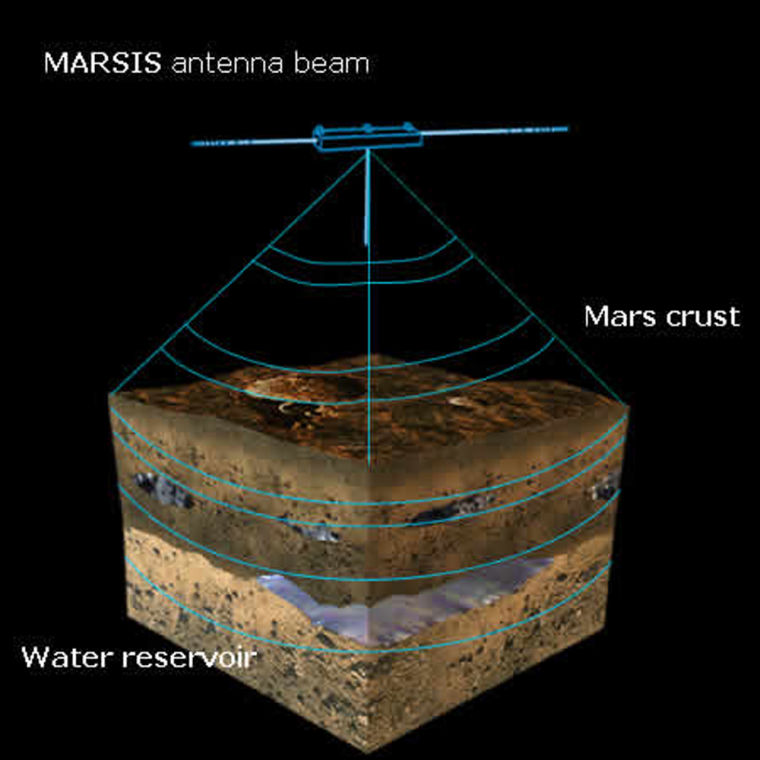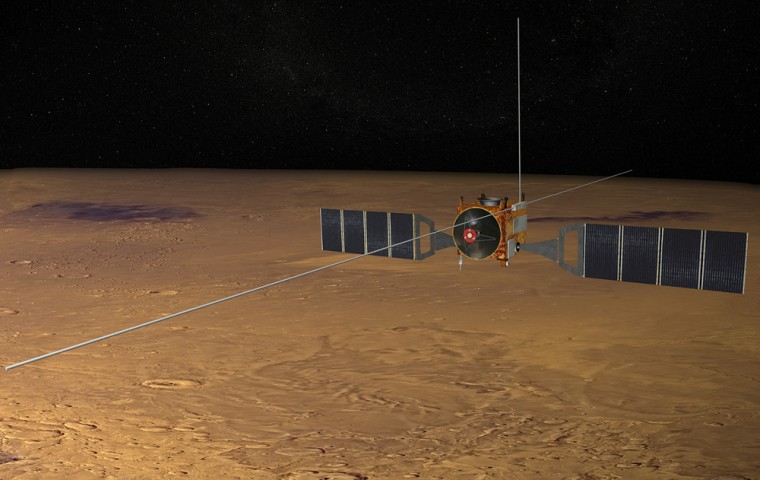European space controllers have successfully completed the extension of the first of three radar antennas on the Mars Express spacecraft now orbiting the Red Planet, after encountering a temporary glitch. The antennas are to be used in an experiment that would look for water beneath the Martian surface.
Engineers confirmed overnight that the first radar boom, which had been partially deployed a week earlier, was now completely out and locked. Deployment of the second boom will be delayed "a few weeks" while engineers study last week's anomaly, the European Space Agency reported Wednesday.
Mars Express has been in orbit for well more than a year, but deployment of the MARSIS ground-penetrating radar had been delayed due to concerns that the flexible antenna structures might whip around violently and damage the spacecraft during their release. Such violent gyrations apparently did not happen, and in fact the initial deployment now seems to have had inadequate force to snap all the antenna segments into alignment.
After the coiled-up antenna was released, engineers at ESA's Mission Control Center in Darmstadt, Germany, indirectly monitored the boom's status by noting subtle vibration patterns, sources told MSNBC.com on condition of anonymity.
Subtle cues
The simple, multisegmented boom had no sensors or other instruments, and the craft's cameras were pointed in another direction. However, the spacecraft did have very sensitive accelerometers on board, and by measuring the extent and timing of the spacecraft's rocking motions, these instruments provided subtle cues as to how far out the boom had extended and how stiff it was.
"Careful examination of the numbers led to approximately where the boom was bent and how much," one program source told MSNBC.com. "Indirect evidence of what was going on was unambiguous."
Over the past week, the ESA team developed a plan to respond to the anomaly.
"As prolonged storage in the cold conditions of outer space could affect the fibreglass and Kevlar material of the boom, the mission team decided to ‘slew’ (or swing) the 680-kilogram [1,496-pound] spacecraft so that the sun would heat the cold side of the boom," ESA reported on its Web site. "This was done so that thermal expansion would force the unlocked segment into place."
ESA said the maneuver began at about 4:20 p.m. ET Tuesday, and when controllers re-established contact with Mars Express at 1:50 a.m. ET Wednesday, an analysis of the data showed that the boom was fully locked.
No further deployments will be attempted until "after a thorough analysis and investigation of the Boom 1 deployment characteristics," ESA said. This will result in the loss of some of the best observational periods: The radar is most effective when it is passing over the dark side of Mars, but as the probe's orbit shifts, it will eventually be lowest over regions that will start becoming sunlit.
Even if all three booms are rolled out successfully, the MARSIS experiment would have to be tested for several weeks. Only then would the radar antenna's 15-watt transmitter begin its scientific work in earnest. Most of the signals would be reflected directly back from the surface, but scientists hope the fraction that penetrates the surface will then be bounced back by layers of materials much farther underground.
High hopes for deep views
The MARSIS team's science goals range from "modest to ambitious," said Jeffrey Plaut, a researcher at NASA's Jet Propulsion Laboratory who is one of the principal investigators for the experiment.

"On the modest side, we are eager to see the interactions of our signals with the ionosphere and the surface of Mars," Plaut wrote in an e-mail to MSNBC.com. "The echoes detected from these two environments will be unlike any data obtained at Mars, and will undoubtedly contain some surprises.
“A bit more ambitious is to detect echoes (layer boundaries) that are unambiguously from the subsurface. This will be a major accomplishment for the experiment,” he continued.
“The fully ambitious goal is to characterize these detected boundaries,” he said — in other words, to “say something about their nature. This is where the search for water comes in.”
Plaut is cautious in his expectations: “It is not at all simple to look at a radar echo history and identify the composition of the reflecting layers. However, if there is a shallow water table in the right geometry, it may have a distinctive radar signature.” The experiment could conceivably detect water that is two or three miles (a few kilometers) beneath the surface.
“Convincing ourselves and our colleagues that this is a verified water detection will be quite a task,” he admitted, “but if we can do it, you might call it hitting a home run.”
Could subsurface water exist as liquid?
Planetary geologists have speculated for decades about exactly how warm it gets beneath the Martian surface, as the planet’s interior heat seeps toward the frigid surface. Some theories had suggested a region of "warm enough" rubble somewhere between the impervious bedrock and the frozen top layers, where water could migrate from the polar ice caps to the warmer equatorial regions. Other geologists told MSNBC.com they believed the layers would be frozen all the way to bedrock.
”We utilized similar models of the subsurface to get an idea of how deep we might detect liquid water,” Plaut explained. “These models depend on the existence (at least locally) of a saturated cryosphere, below which the temperature and the water abundance is sufficient for a groundwater deposit.
“Whether the water is part of a globally connected aquifer tied in with the polar deposits is not really important,” he continued. “The first question is, is the water there? The next would be, how did it get there?”
Tag-team radars
Next year, MARSIS could be joined by yet another ground-penetrating radar system in Martian orbit: the Shallow Radar, or SHARAD, experiment aboard NASA's Mars Reconnaissance Orbiter, which is due for launch in August.
Like MARSIS, SHARAD combines U.S.-built and Italian-built hardware.
”The two differences are depth and vertical resolution,” he pointed out. “MARSIS was designed to probe deep, SHARAD to probe shallow. The advantage MARSIS has is that its low frequencies are the best for deep penetration. The advantage that SHARAD has is that higher frequencies can be used to obtain higher resolution of layers in the vertical dimension.
“One might expect that the shallow zone that SHARAD will investigate is less likely to contain liquid water than deeper zones, simply because it is colder near the surface. On the other hand, if the deep subsurface is devoid of water, SHARAD will better explore the shallow zones which we know contain water ice,” based on spectral observations from other instruments.
MARSIS will also observe the Martian ionosphere, and may even be able to detect ionization trails of meteors. SHARAD, which operates at frequencies about 10 times higher than MARSIS, will not be able to detect anything of interest along those lines.
Some scientists not involved with MARSIS have expressed concerns to MSNBC.com that the radar will not be able to penetrate nearly as deeply as is hoped, due to attenuation from iron-bearing minerals in the Martian soil. In the worst case, the visible depth may only be a tenth as deep as hoped. But even the skeptics expect the radar to see unexpected and unusual geologic features when it begins its observational program.
